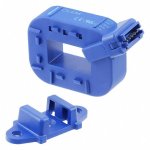wcalvert
Well Known Member
This might be a long shot, but there are some serious brains with varied backgrounds on this forum, so here goes ...
I would like to use a Pololu ACS724 Current Sensor Carrier to measure the amp draw at my alternator in place of a shunt. The V output would be measured by a Dynon general purpose input and displayed by the Ammeter widget.
The parts are available and building a mount isn't difficult. I'm just having a hard time believing that this tiny device can be put in-line on the alternator B lead without cooking.
If you have ANY experience with these devices I would be interested in hearing what you have to say.
Thanks in advance!
I would like to use a Pololu ACS724 Current Sensor Carrier to measure the amp draw at my alternator in place of a shunt. The V output would be measured by a Dynon general purpose input and displayed by the Ammeter widget.
The parts are available and building a mount isn't difficult. I'm just having a hard time believing that this tiny device can be put in-line on the alternator B lead without cooking.
If you have ANY experience with these devices I would be interested in hearing what you have to say.
Thanks in advance!





